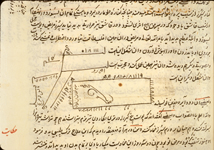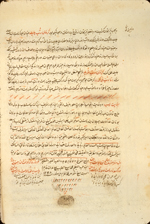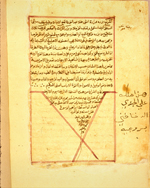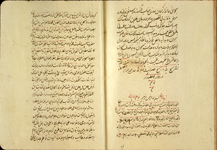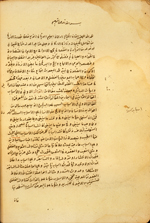Catalogue: Medical Encyclopedias
Encyclopedias
-
 Kifāyah-i Mujāhidīyah
(MS P 28, item 4)
Kifāyah-i Mujāhidīyah
(MS P 28, item 4) - (The Sufficient [book] for Mujahid)
- كفايه مجاهديه
- by Manṣūr ibn Muḥammad ibn Aḥmad ibn Yūsuf Ibn Ilyās (fl. 1380-90)
- منصور ابن محمد ابن احمد ابن يوسف ابن الياس
The medical handbook written by Ibn Ilyās, perhaps better known today for his illustrated treatise on human anatomy (see NLM MS P 18 and P 19 was sometimes called Kifāyah-i Manṣūrī, or "Mansur's Sufficient Book", in reference to Ibn Ilyās's name Mansur. The compendium, however, was more frequently titled Kifāyah-i Mujāhidīyah, or "The Sufficient [Book] for Mujahid" because it was dedicated to the Mujahid al-Dīn Zayn al-‘Abidin, who ruled the province of Fars in Persia from 1384 to 1387 (786-789 H).
The treatise consists of two parts (fanns): The first fann comprises two sections (qisms), the first (in 4 chapters, maqalahs) on the theoretical principles of medicine, and the second (in 5 chapters) on the practical aspects of medicine. The second fann is composed of two chapters (maqalahs), one on materia medica and one on compound remedies.
For other manuscript copies, see Storey PL II,2, p. 225; Richter-Bernburg, "UCLA", pp. 46-51; Keshavarz, "Wellcome", pp. 123-129; and Wilhelm Eilers and Wilhelm Heinz, Persische Handschriften, Teil I [Verzeichnis der orientalischen Handschriften in Deutschland, Band XIV,1] (Wiesbaden: Franz Steiner Verlag, 1968), p. 306 no. 392. This treatise was also lithographed in the 19th century (for copies see Storey PL II,2, pp. 225-6 and Keshavarz, "Wellcome", p. 129).
Kifāyah-i Mujāhidīyah (MS P 28, item 4)
Illustrations
Two sample pages from the Kifāyah-i Mujāhidīyah, a medical compendium by Ibn Ilyās. The copy was completed in 1552/959 H. In the margins of these folios there are 5 Latin squares and four geomantic taskins (orderings of geomantic figures) that have been added by later readers.
The colophon from a copy of the Kifāyah-i Mujāhidīyah by Ibn Ilyās. The copy was completed on the 24th day of the month of Shawwal in 959 [= 13 October 1552]. The copyist is not named.
Physical Description
Persian. 176 leaves (fols. 14b-289b). Dimensions 18.2 x 12.2; text area 12 x 7.7 cm; 17 lines per page. The title is fol. 16a, line 7. The author is given on fol. 15b, lines 16-17, as Manṣūr ibn Muḥammad ibn Aḥmad ibn Yūsuf ibn Faquih Ilyāas. The dedication to Mujahid al-Dīn Zayn al-‘Abdin Muzaffarī is given on fol. 16a.
A complete copy.
According to the colophon on fol. 289b the copy was completed on 24 Shawwal 959 [= 13 October 1552]. The copyist is not named, and the item appears to have been copied by a different scribe from the rest of the volume.
The text is written in a medium-small, widely-spaced ta‘liq tending to naskh script. The letter kaf frequently has a miniature letter on top. The text area has been frame-ruled. Dense black ink with headings in red and red marginal headings. There are catchwords. There are considerable marginalia in several hands. In the marginalia on fol. 28a there is a talismanic anthropomorphic figure; on fol. 51b there three Latin squares and four rows of geomantic taskins (orderings of geomantic figures) used in divination by raml, called geomancy in English; on fol. 52a there are two additional "Latin" squares.
The glossy brown paper has only laid lines visible. The same paper has been used throughout the volume. It is waterstained, especially at the bottom. The paper is stained with grime and thumbing. The edges have been trimmed from their original size. Many folios have had the edges repaired, sometimes using recent watermarked paper.
The volume consists of 290 leaves and three preliminary leaves. Fols. 1a-10a (item 1) are an anonymous Persian illustrated treatise on astronomy copied in 1552/959 by the copyist Sadr al-Din al-mutatabbib (MS P 28, item 1). Fols. 10b-11a (item 2) are an anonymous Arabic essay on vomiting (MS P 28, item 2). Fols. 11b-13a are blank except for later miscellaneous notes. Fols. 13b-14a (item 3) are an story concerning Moses (MS P 28, item 3), and fols. 14b-289b (item 4) is the Kifāyah-i Mujāhidīyah by Manṣūr ibn Muḥammad ibn Aḥmad ibn Yūsuf Ibn Ilyās here catalogued. Fol. 290 has miscellaneous notes. The prelimlinary folio [1a] is blank except for a penciled title for item 4 of the volume; prelim folio [1b] is blank, but for a casual note dated 1284 [= 1867-8]; prelim folio [2a] has a recipe and two owners' notes and a stamp; prelim folio [3a] has miscellaneous notes written at different angles on the page; prelim [3] has miscellanous notes, including a horoscope for 29 Jumadá I 1070 [= 11 February 1660]. There is also a small loose sheet (15 x 11 cm) of watermarked (GAIGLIOTTI) paper with 15 lines of alternating black and magenta writings, with instructions for a talismanic and magical procedure.
Binding
The volume is bound in pasteboards covered with light-brown leather. On each cover there is a blind stamped medallion and two pendants, enclosed by a blind-tooled frame filled with s-shaped stamps; the space between the frame and the medallions has stamped diagonal lines. The spine has been repaired. There are dark-blue paper pastedowns and modern endpapers.
Provenance
The volume was in the collection of the Army Medical Library in 1946. No further information is available on its provenance.
References
Schullian/Sommer, Cat. of incun. & MSS., p. 339 entry P28
NLM Microfilm Reel: FILM 48-137 no. 3
-
 Khulāṣat al-tajārib
(MS P 11, item 1)
Khulāṣat al-tajārib
(MS P 11, item 1) - (The Summary of Experience)
- خلاصة التجارب
- by Bahā’ al-Dīn [or Bahā’ al-Dawlah] ibn Sirāj al-Dīn Shāh Qāsim ibn Muḥammad al-Ḥusaynī Nūrbakhshī (d. ca. 1508/914 H)
- بهاء الدين [بهاء الدوله] ابن سراج الدين شاه قاسم ابن محمد الحسينى نوربخشى
Bahā’ al-Dawlah Nūrbakhshī is known by one treatise, a medical compendium called Khulāṣat al-tajārib (The Summary of Experience) which he composed in 1501/907 H in the village of Turusht, which was near the town of Rayy (near present-day Tehran). It is a comprehensive compendium covering the maintenance of health and the causes, symptoms and treatments of diseases, as well as pharmacology. It also includes anecdotes from the author's own experiences and some discussion of medical terminology current in his day. It comprises 28 chapters (babs): The first 5 concern regimen and hygiene, while the 6th is on fevers. Chapters 7 through 25 concern therapy for diseases specfic to a location in the body, while chapter 26 is on antidotes for poisons and poisonous bites. The 26th chapter is on compound remedies, and the concluding chapter on technical terms encountered in pharmacology.
For other copies, see Richter-Bernburg, "UCLA", pp. 62-65; Storey PL II,2, pp. 230-231; Keshavarz, "Wellcome", pp. 132-134 no. 32 (where the name appears as al-Nuri rather than Nūrbakhshī); and Catalogue of the Arabic and Persian Manuscripts in the Oriental Public Library at Bankipore (Patna: Government Printing), vol. 11, pp. 12-15 (where a complete table of contents is presented).
Khulāṣat al-tajārib (MS P 11, item 1)
Illustrations
Talismanic designs given in the text of Khulāṣat al-tajārib (The Summary of Experience) by Bahā’ al-Dīn Nūrbakhshī. The copy was made in 1832/1248 H by the copyist Ibn ‘Abd al-‘Azim Muḥammad Sami‘ al-tabib (the physician).
The colophon to a copy of Khulāṣat al-tajārib (The Summary of Experience) by Bahā’ al-Dīn Nūrbakhshī. The copy was completed on 5 Muharram 1248 [= 4 June 1832] by the copyist Ibn ‘Abd al-‘Azim Muḥammad Sami‘ al-tabib (the physician).
Physical Description
Persian. 399 leaves (fols. 1b-339b). Dimensions 30.2 x 20.8; text area 22 x 13.3 cm; 23 lines per page. The title is given on fol. 2b, line 11. The author's name is given in the colophon on fol. 339b, lines 14-16, as Bahā’ al-Dawlah ibn Sirāj al-Dīn Shāh Qāsim ibn Muḥammad al-Ḥusaynī al-Nūrbakhshī. On fol. 2b, line 12, there is the statement that the book was based on knowledge he acquired in the year 907 [= 1501-2] in the village of Turusht near Rayy.
A complete copy of the treatise, preceded by a detailed table of contents occupying fols. 1b-2a.
The copy was completed on 5 Muharram 1248 [= 4 June 1832] by Ibn ‘Abd al-‘Azim Muḥammad Sami‘ al-tabib (the physician). Colophon occurs on fol. 339b, lines 17-19.
The text is written in a small to medium-small nasta‘liq script. Black ink with headings in red, red overlinings, and some marginal headings. There are catchwords. The marginal corrections appear mostly to have been made by the scribe.
There are small diagrammatic illustrations of talismanic designs on fol. 242a (old 241 bis) and fol. 268b.
The creamy, smooth, glossy paper has evident watermarks, with laid lines and single chain lines. There is water damage near the edges; the edges have been trimmed from their original size.
The volume contains 342 leaves. Fols. 340a-341a is a formulary by Aḥmad ibn Farrukh (MS P 11, item 2); fol. 341a, line 20,-342a is an anonymous essay on antidotes for poisons (MS P 11, item 3). Fol. 342b is blank. Between fols. 33 and 34 and between fols. 181 and 182 there are small slips of paper with jottings in a modern hand. The first 250 leaves have been numbered with Arabic numerals, with two leaves given the number 241. Consequently, the recent foliation using Western numerals differs by one, beginning with fol. 242 (old fol. 241 bis).
Binding
The volumes is bound in pasteboards covered with black leather. Each cover has a blind-tooled and lacquered appliquéd floral medallion and two smaller devices, surrounded by two blind-tooled frames, one filled with tooled braiding. The spine and edges have been repaired. There are blue paper pastedowns and modern endpapers.
Provenance
On fol. 1b there is an owner's stamp and an owner's note on fol. 1a; neither are legible.
The volume was purchased by the Army Medical Library in 1946 from A.S. Yahuda, who acquired if from a dealer in Lahore, Pakistan (ELS 1615).
References
Schullian/Sommer, Cat. of incun. & MSS., p. 333 entry P11.
NLM Microfilm Reel: FILM 48-133 no. 1
-
 Risālat al-nuzhah al-mubhijah fī tashḥīdh al-adhhān wa-ta‘dīl al-amzijah (MS A 52)
Risālat al-nuzhah al-mubhijah fī tashḥīdh al-adhhān wa-ta‘dīl al-amzijah (MS A 52) - (Pleasure and Delight in Sharpening the Intellect and Correcting the Temperaments)
- رسالة النزهة المبهجة فى تشحيذ الاذهان وتعديل الامزجة
- by Dā’ūd ibn ‘Umar al-Anṭākī (d. 1599/1008 H)
- داود ابن عمر الانطاكي
The medical compendium by Dā’ūd ibn ‘Umar al-Anṭākī with the elaborate title Risālat al-nuzhah al-mubhijah fī tashḥīdh al-adhhān wa-ta‘dīl al-amzijah (Pleasure and Delight in Sharpening the Intellect and Correcting the Temperaments) is not generally as well-known as his very popular Tadhkirah or "Memorandum Book", though it is often printed in the margins of modern printings of the Tadhkirah. The Nuzhah is a systematic work on medicine, with an introduction (muqaddimah), seven chapters (babs), and a conclusion (khatimah). In the course of the treatise, all the basic principles of medicine are discussed, including diagnosis and therapy. The copy at NLM was made by a prominent Egyptian writer on philology, Ibrahim al-Dasuqi, who died in 1883.
For other manuscript copies, see Ullmann, Medizin, pp. 181 note 6; GAL, vol. 2, p. 364 (478) and GAL-S, vol. 2, p. 491; and Catalogue of Islamic Medical Manuscripts (in Arabic, Turkish, and Persian) in the Libraries of Turkey, ed. Ekmeleddin Ihsanoglu (Istanbul: Research Centre of Islamic History, Art and Culture, 1984), pp. 230-231.
Risālat al-nuzhah al-mubhijah fī tashḥīdh al-adhhān wa-ta‘dīl al-amzijah (MS A 52)
Illustrations
The colophon in a copy of Dā’ūd ibn ‘Umar al-Anṭākī's Risālat al-nuzhah al-mubhijah fī tashḥīdh al-adhhān wa-ta‘dīl al-amzijah. It was copied by a well-known Egyptian writer on philology, Ibrāhīm al-Dasūqī, and completed on 20 Muharram 1259 [= 20 February 1843].
Physical Description
Arabic. 200 leaves (fols. 1a-200b). Dimensions: 22 x 16.2; text area 17 x 9.7 cm; 23 lines per page. The title is given on the title page (fol. 1a) and in the text itself at fol. 1b, line 2. The author's name is given on the title page as Dā’ūd al-Anṭākī.
According to the colophon on fol. 200b, the copy was completed on 20 Muharram 1259 [= 20 February 1843] by Ibrāhīm al-Dasūqī. The copyist is in fact a well-known Egyptian writer on philology who died in 1883. For Ibrāhīm ibn ‘Abd al-Ghaffar al-Dasūqī (1811-1883), see GAL vol. 2 p. 478, no. 4 (p. 629).
The text is written in a medium-small, very careful naskh script. Brown ink with headings in light-red. The text is written within frames of double maroon-red inked lines. There are catchwords. There are some red marginal headings and some marginal corrections by the copyist, with scattered marginal notes that were added later. Fol. 182 is written in a different hand, with 31 lines to the page.
The creamy, semi-glossy paper has no visible laid lines or chain lines. There are a few worm holes and some waterstaining near the edges. Fols. 1 and 200 are guarded.
The volume consists of 200 leaves.
Binding
The volume is bound in pasteboards and envelope flap covered with dark-red leather. On the covers and flap there are block-stamped medallions and blind-tooled borders. There are modern paper pastedowns and endpapers.
Provenance
There is an owner's note on fol. 200b and also on fol. 1a. The volume was purchased in 1941 by the Army Medical Library from A.S. Yahuda (ELS 455 AUT.S25). No further information is available on its provenance.
References
Schullian/Sommer, Cat. of incun. & MSS., pp. 314-315 entry A52.
NLM Microfilm Reel: FILM 48-122 no. 4
-
 Zubdat al-bayān fī ‘ilm abdān
(MS P 7, item 3)
Zubdat al-bayān fī ‘ilm abdān
(MS P 7, item 3) - (The Best Explanation in the Science of Bodies)
- زبدة البيان فى علم الابدان
- by ‘Abd Allāh ibn Aḥmad ibn Muḥammad al-Asfarā’nī, known as Abū Bakr (before 1826/1241 H)
- عبد الله ابن احمد ابن محمد الاسفرائنى المشتهر بابي بكر
The short medical compendium entitled Zubdat al-bayān fī ‘ilm abdān (The Best Explanation in the Science of Bodies) is preserved in a unique copy now in the collections of NLM. The author is given as ‘Abd Allāh ibn Aḥmad ibn Muḥammad al-Asfarā’nī, known as (al-mushtahar bi-) Abū Bakr. The copy of the treatise is undated, but it appears to have been copied by the same scribe who finished copying another treatise in the volume on 22 Dhu al-Hijjah 1241 [= 28 July 1826]. Therefore, the only statement that can be made with certainty is that the author was active before 1826.
The treatise is stated to consist of an introduction (muqaddimah) and at least 8 chapters (babs), though the only known copy breaks off abruptly in the midst of the 6th chapter.
No other copy of the treatise is recorded and the author is otherwise unknown.
Zubdat al-bayān fī ‘ilm abdān (MS P 7, item 3)
Illustrations
The opening of a unique copy of a medical compendium by an otherwise unknown author named #8216;Abd Allāh ibn Aḥmad ibn Muḥammad al-Asfarā’nī, known as (al-mushtahar bi-) Abu Bakr.The text begins at line 12 of fol. 166b. Above that, there is a colophon for the previous treatise in which it is said that the copy was completed on 22 Dhu al-Hijjah 1241 [= 28 July 1826].
Physical Description
Persian. 8 leaves (fols. 166b-173b). Dimensions: 21.2 x 12.6; text area 14.5 x 7 cm; 18 lines per page. The title is given at the start of the treatise (fol. 166b, line 13) and again in the text on fol. 167a, line 18. The author's name is given on fol. 167a, line 2, as #8216;Abd Allāh ibn Aḥmad ibn Muḥammad al-Asfarā’nī, known as (al-mushtahar bi-) Abū Bakr.
It is an incomplete copy, for the text breaks off abruptly at the top of fol. 173b in the midst of the 6th bab.
The copy was made by the same unnamed scribe who transcribed the previous item in the volume, which was completed on 22 Dhu al-Hijjah 1241 [= 28 July 1826]. The colophon for the previous item is given on fol. 166b, immediately before the start of this third item.
The text is written in a small nasta‘liq script. The text area is frame-ruled. Black ink with maroon headings and overlinings. There is a marginal commentary that is written in the same hand as the central text. There are catchwords for the central text. This item begins on line 12 of fol. 166b, immediately after the second item in the volume.
Two types of paper has been used in the volume: a creamy, glossy paper with neither laid lines nor chain lines, and a lightly-glossed gray-green paper that is watermarked (1824). The papers are mixed throughout the volume. The edges have been trimmed from their original size.
The volume consists of 174 leaves. Fols. 1a-12b, 73b-75a and 174b are are blank. Item 1 (fols. 14a-73a is an anonymous treatise on compound remedies (MS P 7, item 1). Item 2 (fols. 75b-166b) is Dastūr al-‘ilāj by Sulṭān ‘Alī Khurāsānī (MS P 7, item 2); and item 3 (fols. 166b-173b) is a medical compendium Zubdat al-bayān fī ‘ilm abdān by al-Asfarā’nī here catalogued. All the items are copied by the same copyist. Fol. 13a has many owners' notes, and fol. 13b has miscellaneous notes that continue on fol. 14a. Folio 174a has miscellaneous therapeutic notes written in Persian in two directions on the page.
Binding
The volume is bound in a soft black leather binding. Both covers have blind-tooled frames enclosing rectilinear designs. There are pink paper pastedowns and modern endpapers.
Provenance
On fol. 13a there is an owner's stamp dated 1239 with the name Ibn Muḥammad ‘Abd Rafī‘ al-Ḥusaynī al-Wahhāb. There are also six undated owners' notes, one for ‘Abd al-Mudhanab al-Iṣfahānī.
The volume was acquired by the Army Medical Library in 1946 from A.S. Yahuda, who acquired it from a dealer in Hyderabad, India
(ELS 1686, Med. 42).
References
Schullian/Sommer, Cat. of incun. & MSS., pp. 331-2 entry P7.
NLM Microfilm Reel: FILM 48-132 no. 2
-
 Muhimmāt al-dalā'il wa-ummahāt al-masā'il
(MS A 84, item 5)
Muhimmāt al-dalā'il wa-ummahāt al-masā'il
(MS A 84, item 5) - (Important Symptoms and Basic Problems)
- مهمات الدلائل وامهات المسائل
- Anonymous
The unnamed author states: "This epitome of the art of medicine (mukhtasar fī sina‘at al-tibb) I composed for students ... and I named it Important Symptoms and Basic Problems, and I divided it into three sections (maqalahs)." No information is available on when or where it was written, though it must have been before 1564/971 H when the copyist transcribed the treatise.
No other copy appears to be recorded other than the one in the collections of NLM.
Muhimmāt al-dalā'il wa-ummahāt al-masā'il (MS A 84, item 5)
Illustrations
The beginning of an anonymous guide to the medical art that, according to the author's statement in lines 7-9, was composed for students and titled Important Symptoms and Basic Problems (Muhimmāt al-dalā'il wa-ummahāt al-masā'il).
Physical Description
Arabic. 14 leaves (fols. 46a-59b) Dimensions 20.8 x 14.5; text area 14.2 x 7.5 cm; 23 lines per page. The title is given on fol. 46b, lines 7-9. The author is not named.
The copy is incomplete, for it breaks off abruptly at the end of fol. 59b before the end of the treatise.
The treatise was copied by the same copyist who transcribed the other four items in the volume. In the colophon to the first item (fol. 39a) it is stated that the transcription (naql) was completed at the beginning (fi ibtida') of the month of Sha‘ ban 971 [ = March 1564] by a scribe named Mas‘ūd ibn Mas‘ūd ibn ‘Alī known as (mulaqqab bi-) Kamāl al-Dīn al-Kirmānī.
The text is written in a small compact naskh, with some ligatures. Black ink with headings in red and red overlinings. There are catchwords. The leaves have been frame-ruled, and sometimes the final letters of a word at the end of a line are written at a distance outside the ruling line. There are some marginalia.
The beige lightly-glossed paper has single chain lines and watermarks. The paper is waterstained, and the edges have been trimmed from their original size.
The volume consists of 59 leaves. Fols. 1-39a has an encyclopedia by Mas‘ud ibn Muhammad al-Sijzi (MS A 84, item 1). Fols. 39b-41a contain a treatise falsely attributed to Hippocrates (MS A 84, item 2); fols. 41a-44a have a synopsis of a treatise by Galen (MS A 84, item 3); and fols. 44b-46a a tract by al-Razi (MS A 84, item 4). All the items are copied by the same copyist.
Binding
The volume is bound in a modern library binding of brown leather over boards. Modern pastedowns and endpapers.
Provenance
The volume was purchased in 1941 by the Army Medical Library from A.S. Yahuda (ELS No. 1708; Med. 19).
References
Schullian/Sommer, Cat. of incun. & MSS, p. 325 entry A 84 item 5, where the title is given as Mukhtasar fi al-tibb.
NLM Microfilm Reel: FILM 48-17 no. 4
A short collections of untitled extracts from various medical writings, including (or perhaps primarily) from Ibn Sīnā (Avicenna).
Physical Description
Arabic. 2 leaves (fol. 174b-175a). Dimensions 23.2 x 15.8; text area 17.8 x 11.5; 22-23 lines per page. On the first line of fol. 174b al-shaykh Abū ‘Alī ibn Sīnā is cited.
These two leaves contain fragments, or selections, from several medical sources, the first being that of Ibn Sīnā (Avicenna).
The copy is undated. The general appearance of the paper, ink, and script suggests a date of the 18th century.
The text is written in a small naskh script (Turkish hand?). Black ink, with no rubrications. There are some marginalia.
The ivory paper is thick and stiff, with visible laid and single chain lines (no evident watermark). Black ink.
The volume consists of 186 leaves. It is a mixed volume with 18 different items in it, copied by at least two different copyists. Item 1 (fols. 1a-3b) is an anonymous alchemical fragment (MS A 87, item 1), item 2 (fols. 4a-54a) is the abridgement of a treatise called al-Bayān by Ibn Jazlah (MS A 87, item 2), and item 3 (fols. 54b-64b) extracts from al-Bayān [by Ibn Jazlah] (MS A 87, item 3). Item 4 (fols. 65b-68a) is an anonymous, untitled essay on stones (MS A 87, item 4), item 5 (fols. 68b-74a) an anonymous collection of therapeutic procedures (MS A 87, item 5), and item 6 (fols. 74a-75b) on regimen for infants, extracted from Kitāb al-Bayān [? Ibn Jazlah] (MS A 87, item 6). Item 7 (fols. 76a-96b) is the anonymous treatise on materia medica (MS A 87, item 7); item 8 (fols. 97a-100a) an anonymous tract on medicinal oils (MS A 87, item 8), and item 9 (fols. 100b-121a) a magical-medical treatise by Ibn Tūmart al-Maghribī (MS A 87, item 9). Item 10 (fols. 121b-125a) is an anonymous alphabetical list of medicaments (MS A 87, item 10), and item 11 (fols. 125b-140b) is the commentary on an identified "poem on the principles of the art of medicine" (MS A 87, item 11). Item 12 (fols. 140b-142a) contains selections from Kitāb al-Ḥāwī fī ‘ilm al-tadāwī by Najm al-Din al-Shirazi (MS A 87, item 12), and item 13 (fols. 142b-157b, 159a-172a) is an untitled anonymous treatise in five chapters on medicine, magic, and divination (MS A 87, item 13). Item 14 (fols. 172b-174a) is an anonymous tract on divination (MS A 87, item 14), item 15 (fols. 174b-175a) untitled extracts from medical writings here catalogued, and item 16 (fols. 175a-181b) is an anonymous astrological treatise (MS A 87, item 16). Item 17 (fols. 182a-184b) is an anonymous treatise titled Dā'ir muḥibb fī ‘ilm al-ṭibb, on magical medicine (MS A 87, item 17), while the final item, item 18 (fols. 185a-186b), is an anonymous essay on the numerical values of letters and magic squares (MS A 87, item 18).
Binding
The volume is bound in pasteboards covered with brown leather, over which light-brown paper has been placed on the covers. There is a recent brown leather spine. The paper pastedowns are contemporary with the manuscript and are covered with miscellaneous notes.
Provenance
There is an owner's signature dated 1268 [= 1851-2] on fol. 3b of the volume, and there are several owners' notes on fol. 4a.
The volume was purchased in 1941 by the Army Medical Library from A.S. Yahuda, who acquired it fram a dealer in Sanaa, the Yemen (ELS 2369).
References
Schullian/Sommer, Cat. of incun. & MSS., pp. 326-7 entry A87 (this item not described).
NLM Microfilm Reel: FILM 48-129 no. 4

![MS P 28, fol. 51b Folio 51b from Ibn Ilyās's Kifāyah-i Mujāhidīyah (The Sufficient [book] for Mujahid) featuring three Latin squares and geomantic taskins in the top and right margin. The glossy brown paper has only laid lines visible and is waterstained. The text is written in a medium-small, widely-spaced ta‘liq tending to naskh script using dense black ink with headings in red and red marginal headings.](images/p2851bThumb.jpg)
![MS P 28, fol. 52a Folio 52a from Ibn Ilyās's Kifāyah-i Mujāhidīyah (The Sufficient [book] for Mujahid) featuring two Latin squares and geomantic taskins in the top and left margin. The glossy brown paper has only laid lines visible and is waterstained. The text is written in a medium-small, widely-spaced ta‘liq tending to naskh script using dense black ink with headings in red and red marginal headings.](images/p2852aThumb.jpg)
![MS P 28, fol. 289b The top of folio 289b from Ibn Ilyās's Kifāyah-i Mujāhidīyah (The Sufficient [book] for Mujahid) featuring the colophon. The glossy brown paper has only laid lines visible and is waterstained. The text is written in a medium-small, widely-spaced ta‘liq tending to naskh script using dense black ink.](images/p28289bThumb.jpg)
